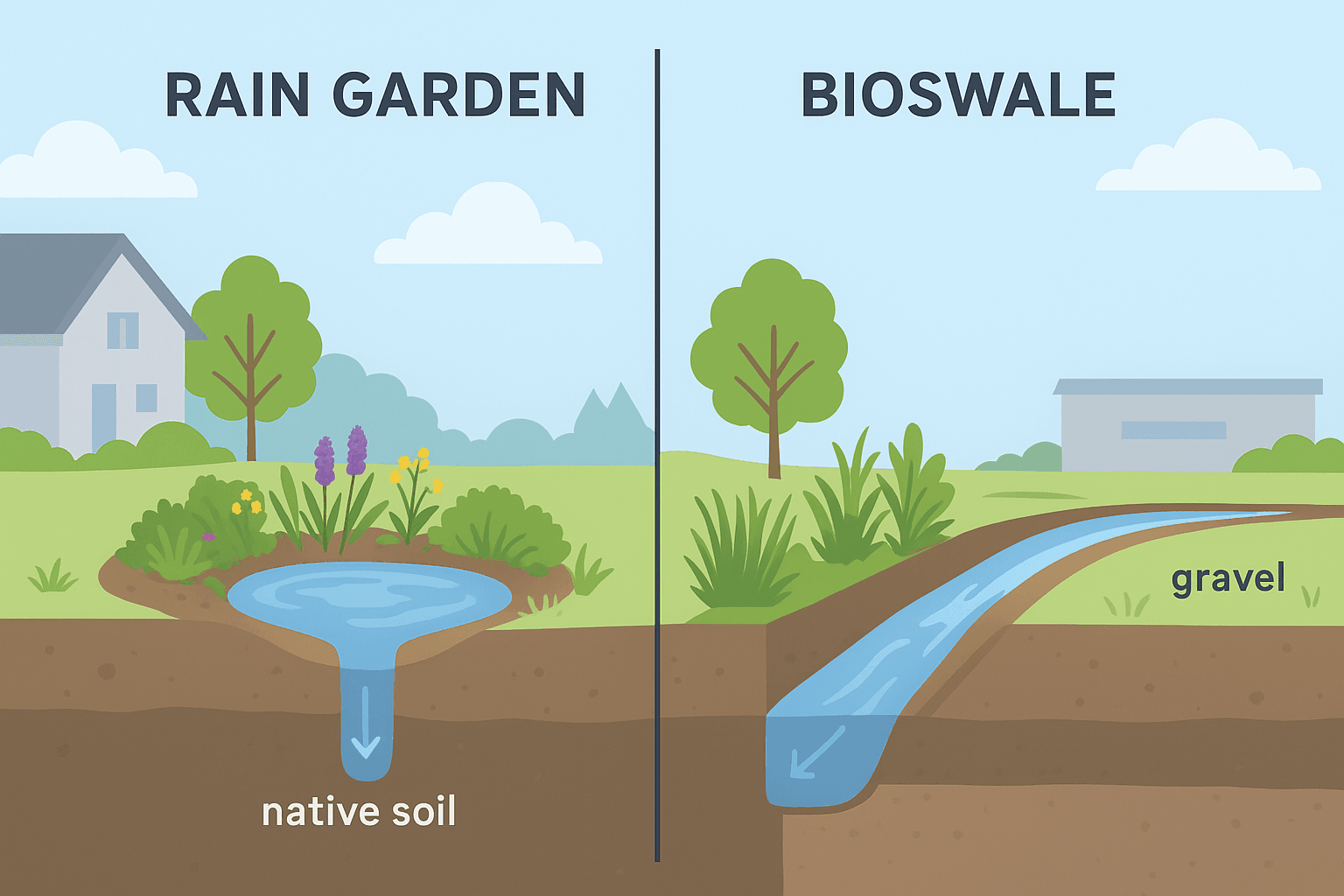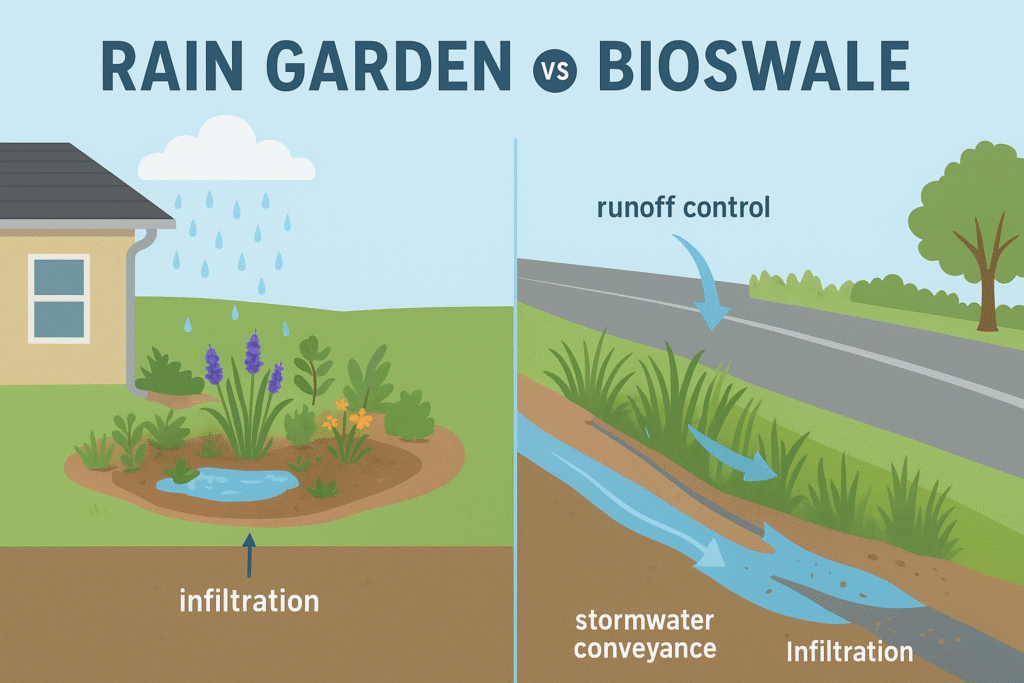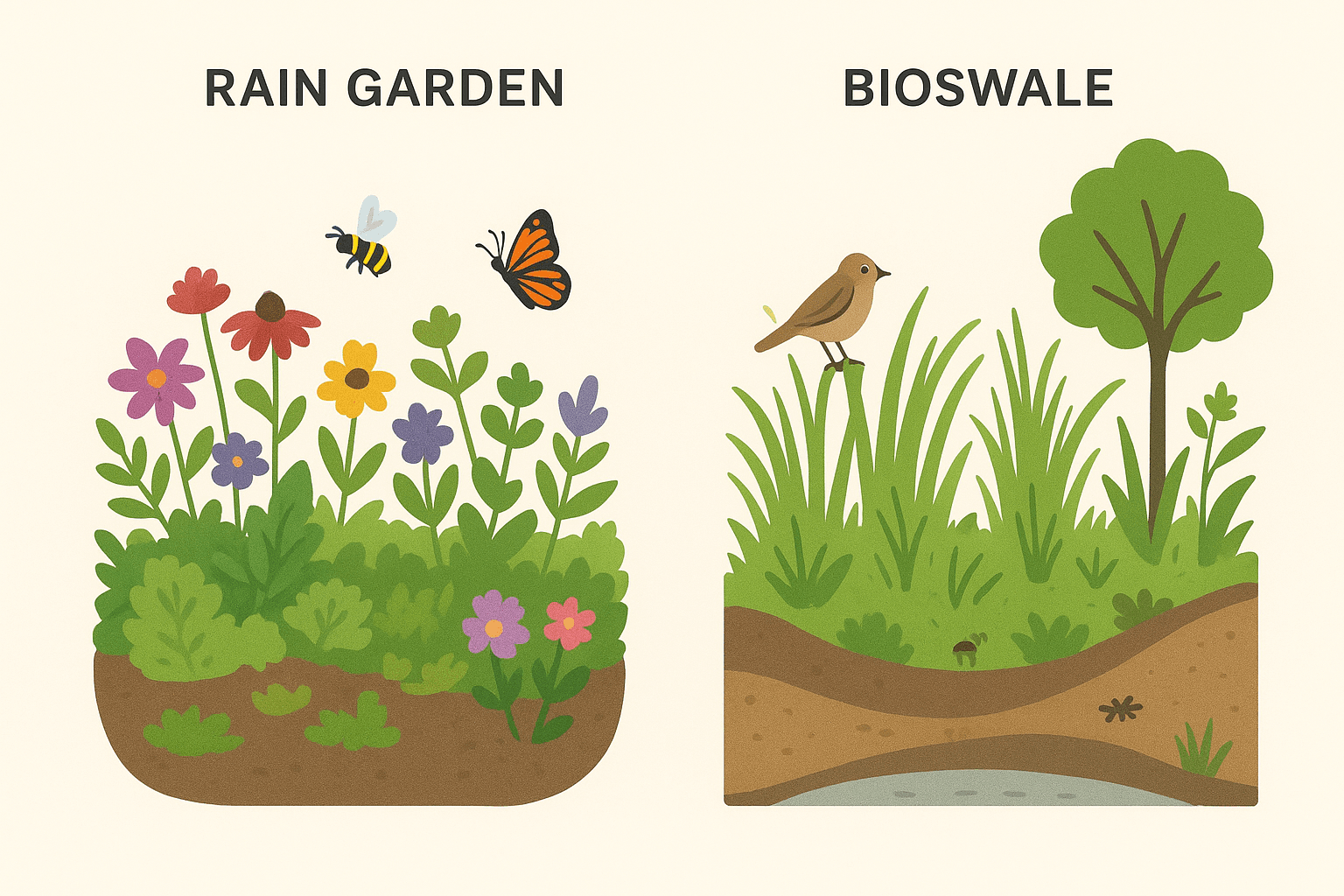
Rain garden and bioswales are two green infrastructure practices that are designed to manage stormwater but they differ in structure and purpose. A rain garden is a shallow landscape depression planted with native vegetation to absorb and filter runoff that is close to its source.
On the other hand, a bioswale is a vegetated channel that is built to slow, direct and treat larger volumes of stormwater as it moves through the landscape. Both systems reduce flooding, filter pollutants and enhance urban greenery. But they have lots of differences like their design, scale and functionality that we are going to see in this blog -Rain garden vs bioswale.
Table of Contents
ToggleWater flow and Retention Comparison
Rain gardens emphasize water retention and infiltration at the source while bioswales focus on directing and treating flowing water across a site. One of the most critical differences lies in how each system handles water flow and Retention whenever we are comparing a rain garden vs bioswale.
A rain garden is designed as a shallow basin that temporarily collects runoff from roofs, driveways or lawns. Water infiltrates directly into the soil which allows pollutants to be filtered while recharging groundwater. This makes them highly effective for capturing smaller & localised storm events where infiltration is the priority.
In contrast, a bioswale functions more like a conveyance channel. Instead of holding water in one spot it slows the movement of large amounts of water that travel through a vegetated swale. A perfect design with a gentle slope encourages infiltration along the way but its main role is to guide stormwater safely into drains, wetlands or other collection points. This makes bioswales capable of handling higher flow rates and that’s why they’re used in parking lots, roadways or commercial landscapes.

Structural Design and Form comparison
Rain gardens excel in localised stormwater retention whereas bioswales dominate in managing and conveying large-scale runoff in urban or industrial settings. When we compare Rain garden vs bioswale; their shape, slope and structure are among the most visible differences.
A rain garden is typically a basin-like depression (rounded or kidney-shaped) with gentle sloping edges designed to hold water for a short time, promote infiltration and let it soak into the ground. The bottom of a rain garden is flat or slightly convex to slow water and the sides may be terraced or have berms to contain overflow safely.
In contrast, a bioswale is a linear channel that is long and narrow with a defined slope (1-6%) that guides water across the landscape toward an outflow. Instead of holding water in a place, bioswales use sloped sides and engineered grading to move water through vegetation and soil. Many bioswales include features like check-dams, gravel beds or underdrain pipes to help stormwater management when soil infiltration is poor.
Another structural distinction is depth and layering. Rain gardens usually are shallower (e.g. 4-10 inches) and depend more on native soil amended for permeable layers. Bioswales are deeper trenches with layers of gravel, engineered soil media and sometimes overflow channels. Structure will decide their capability to handle runoff control, water retention and movement during storms.
Scale and stormwater capacity
Rain gardens focus on small site runoff control while bioswales are designed to move and treat large-scale surface water across landscapes. Both complement each other in modern green infrastructure but their capacity determines where and which one is effective. Rain gardens and bioswales diverge clearly in terms of the capacity to handle stormwater.
A rain garden is typically designed on a small residential or community scale. It captures runoff from rooftops, patios or short driveways. It’s a shallow basin that collects water from a limited area usually from a single property and allows it to infiltrate gradually. This makes rain gardens best for households or neighbourhoods that are aiming for localised flood prevention and groundwater recharge.
On the other hand, a bioswale operates on a much larger footprint. It does not serve a single lot, it can intercept water flowing from entire streets, parking areas or commercial zones. The channel-like design and engineered soil layers make it capable of conveying high volumes while still filtering pollutants along the way. And that’s why bioswales are often integrated into urban stormwater management systems to handle those flows that rain gardens cannot manage.

Soil Composition and Filtration Layers
Rain garden soils focus on removing nutrients, pesticides and metals in small volumes but bioswale layers are structured to capture sediments, oils and hydrocarbons from road runoff. Rain gardens rely on natural soil improvement whereas bioswales demand layered engineering to function efficiently. The foundation of both systems lies under the surface and here the rain garden vs bioswale comparison becomes more important.
A rain garden is usually constructed with native soil amended with compost or sand that improves permeability while supporting deep-rooted native plants. The soil mix is designed to hold water for 24-48 hours before draining & balancing retention with plant health. The soil layers are simpler (often 18-24 inches) because rain gardens are shallow. It makes them relatively easy to install in residential yards.
On the other hand, bioswales require a more engineered soil profile. They often incorporate multiple layers: a surface planting soil for vegetation, a sandy loam layer for infiltration, gravel or rock beds for stability and sometimes a perforated underdrain pipe to handle overflow. This design allows bioswales to manage continuous flows and prevent waterlogging even during intense storms. Unlike rain gardens, bioswales must be graded carefully so that water moves along the channel.
Vegetation and Wildlife Habitat
The difference is clear: rain gardens emphasize aesthetic diversity and pollinator habitat whereas bioswales focus on durable vegetation for erosion control and continuous flow management. Your plant Choices is what that sets a rain garden apart from a bioswale.
A rain garden typically features a mix of native wildflowers, shrubs and grasses that thrive in both wet and dry cycles. These plants develop deep roots systems that increase infiltration, stabilize soil and provide habitat for pollinators like bees, butterflies and beneficial insects.
Many rain gardens also attract songbirds due to their flowering species and sees producing plants. They can be tailored to support urban biodiversity because they are smaller in scale. On the other hand, bioswales are planted with hardy, low-maintenance vegetation that can tolerate constant flows and occasional drought. Grasses, sedges and rushes are common choices because their fibrous roots resist erosion and trap sediments effectively.
Trees or large shrubs are sometimes added along with bioswale edges to provide shade and increase water uptake, but the vegetation inside the channel must withstand against heavy runoff. Bioswales’ primary role is stormwater treatment so that’s why their planting is often more functional than ornamental.

Installation Complexity and Cost – Rain Garden vs Bioswale
Rain gardens are cost effective and DIY friendly while bioswales involve higher installation costs and engineering expertise. Your choice depends on whether your goal is small scale residential runoff control or large-scale urban stormwater management. The process of building a rain garden vs bioswale are different in both effort and expense.
A rain garden is straightforward to install and often requires little more than shallow excavation, soil amendments and native plantings. Homeowners or community groups can even construct small rain gardens themselves with basic tools.
The costs vary as it depends on size and plant selection but usually range from a few hundred to a couple of thousand dollars for residential projects. This criteria makes them one of the most affordable green infrastructure options.
However, bioswales demand more engineering and professional input. They require careful grading to ensure the slope effectiveness along with excavation for gravel layers, soil media and sometimes underdrain systems. Erosion control features such as check dams or rock inlets further add to structure complexity. Since bioswales can be scaled largely (roadways, parking lots of commercial landscapes), they typically cost more — around thousands of dollars.
Maintenance and longevity comparison
Rain gardens offer low effort longevity while bioswales require regular & structured maintenance but deliver durability at scale. Long term performance depends heavily on upkeep and here the difference between rain gardens and bioswales becomes clear.
Rain gardens are relatively low maintenance once they’re established. In their first year they require weeding, watering and mulching to help native plants to take root. After that seasonal checks like removing invasive weeds, trimming overgrowth and replacing mulch are usually enough. A healthy vegetation can help a rain garden to last for decades with minimal inputs.
However, bioswales demand more frequent attention because they handle higher volumes of runoff, sediment build-up, trash and road pollutants. Their maintenance includes sediment removal, inspection of underdrain pipes, regrading eroded areas and reseeding vegetation where flows are strong. Municipal crews or trained landscapers are usually needed, especially for large installations.
Despite the higher effort, a well maintained bioswale can function effectively for 20-50 years by ensuring long term stormwater control in urban environments.

Pollutant Filtration and Environmental Impact- comparison
These systems tackle different aspects of urban pollution: rain gardens filter localized household runoff while bioswales manage large-scale, transport related contaminants.
Both systems improve water quality but they target pollutants by different methods. A rain garden act like a natural sponge where soil microbes and plant roots filter fertilizer, pesticides and heavy metals from small runoff sources. Studies shows that rain gardens can remove up to 90% of nutrients and sediments when they’re properly designed.
And they also recharge groundwater and cool surrounding areas with offering climate resilience benefits. A bioswale is built to handle tougher runoff challenges. They capture oil, grease, microplastics and fine sediments that wash off during storms around roads and parking lots. Their layered soil media and dense root systems slows water and give time to pollutants to be settled & break down.
Bioswales may not recharge groundwater effectively like rain garden but their broader environmental impact lies in reducing polluted discharge into rivers, lakes and coastal waters. According to a study published on the Food and Agriculture Organization database, rain gardens reduced runoff volume by around 54.08%, while bioswales performed even better with reductions up to 98.25% in certain conditions.
Faqs
What is the main difference between a rain garden and a bioswale?
The main difference between – rain garden vs bioswale is that : a rain garden is a shallow landscapes depression that captures and infiltrates water on-site. However, a bioswale is a linear channel that is designed to slow, move and filter larger volumes of stormwater.
Which is more cost-effective - rain garden vs bioswale
Rain gardens are generally more affordable and can often be built as a DIY project for residential properties. But bioswales require engineered designs and professional installation that makes them more expensive and effective for large urban areas.
Do rain gardens and bioswales both help with water pollution?
Yes, both systems improve water quality but in different ways. Rain gardens filter fertilizers, pesticides and sediments from household runoff but on the other hand, bioswales capture oils, heavy metals and road pollutants from larger surfaces like parking lots and streets.
